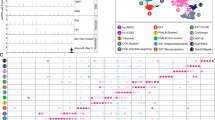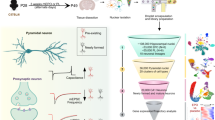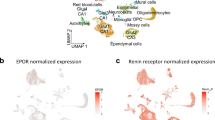Abstract
The transcription factors signal transducer and activator of transcription 5a and 5b (Stat5) are activated by the neuroprotective and neurotrophic cytokines, erythropoietin (EPO) and growth hormone (GH). Here, we show a dissociation of the intracellular pathway mediating the protective effect of EPO against glutamate toxicity from that needed for its neurotrophic activity using hippocampal neuronal cultures from Stat5a/b-knockout (Stat5−/−) mouse fetuses. Both pretreatment and post-treatment with EPO counteracted glutamate-induced cell death in Stat5+/+ and Stat5−/− neurons. Acute pharmacological inhibition of Janus kinase 2 (JAK2)/Stat signalling had no effect on EPO neuroprotection, whereas inhibition of phosphatidylinositol-3′ kinase (PI3K)/Akt pathway abolished the protective effect of EPO in both Stat5+/+ and Stat5−/− neurons. GH effectively protected Stat5+/+ cells against glutamate toxicity but had no effect in Stat5−/− neurons or in Stat5+/+ neurons treated with JAK2/Stat or PI3K inhibitor. EPO and GH stimulated neurite outgrowth and branching of Stat5+/+ neurons by activating PI3K/Akt signalling but had no trophic effect in Stat5−/− cells. We conclude that in hippocampal neurons, Stat5 is not required for neuroprotection by EPO but is together with Akt essential for its neurotrophic activity. Both Stat5 and Akt are needed for neuroprotective and neurotrophic signalling of GH in neurons.
Similar content being viewed by others
Log in or create a free account to read this content
Gain free access to this article, as well as selected content from this journal and more on nature.com
or
Abbreviations
- D-AP-5:
-
D-(−)-2-amino-5-phosphonopentanoic acid
- DIV:
-
days in culture
- E:
-
embryonic day
- EPO:
-
erythropoietin
- EPOR:
-
EPO receptor
- GH:
-
growth hormone
- JAK2:
-
Janus kinase 2
- NMDA:
-
N-methyl-D-aspartate
- NR2A:
-
NMDA receptor subunit 2A
- NR2B:
-
NMDA receptor subunit 2B
- PI3K:
-
phosphatidylinositol-3′ kinase
- Stat:
-
signal transducer and activator of transcription
References
Ihle JN . The Stat family in cytokine signaling. Curr Opin Cell Biol 2001; 13: 211–217.
Cui Y, Riedlinger G, Miyoshi K, Tang W, Li C, Deng CX et al. Inactivation of Stat5 in mouse mammary epithelium during pregnancy reveals distinct functions in cell proliferation, survival, and differentiation. Mol Cell Biol 2004; 24: 8037–8047.
Markham K, Schuurmans C, Weiss S . STAT5A/B activity is required in the developing forebrain and spinal cord. Mol Cell Neurosci 2007; 35: 272–282.
De-Fraja C, Conti L, Magrassi L, Govoni S, Cattaneo E . Members of the JAK/STAT proteins are expressed and regulated during development in the mammalian forebrain. J Neurosci Res 1998; 54: 320–330.
Ting CH, Lin CW, Wen SL, Hsieh-Li HM, Li H . Stat5 constitutive activation rescues defects in spinal muscular atrophy. Hum Mol Genet 2007; 16: 499–514.
Sirén AL, Fratelli M, Brines M, Goemans C, Casagrande S, Lewczuk P et al. Erythropoietin prevents neuronal apoptosis after cerebral ischemia and metabolic stress. Proc Nat Acad Sci USA 2001; 98: 4044–4049.
Um M, Lodish HF . Antiapoptotic effects of erythropoietin in differentiated neuroblastoma SH-SY5Y cells require activation of both the STAT5 and AKT signaling pathways. J Biol Chem 2006; 281: 5648–5656.
Yu X, Shacka JJ, Eells JB, Suarez-Quian C, Przygodzki RM, Beleslin-Cokic B et al. Erythropoietin receptor signalling is required for normal brain development. Development 2002; 129: 505–516.
Zhang F, Wang S, Cao G, Gao Y, Chen J . Signal transducers and activators of transcription 5 contributes to erythropoietin-mediated neuroprotection against hippocampal neuronal death after transient global cerebral ischemia. Neurobiol Dis 2007; 25: 45–53.
Liu J, Narasimhan P, Yu F, Chan PH . Neuroprotection by hypoxic preconditioning involves oxidative stress-mediated expression of hypoxia-inducible factor and erythropoietin. Stroke 2005; 36: 1264–1269.
Brines M, Cerami A . Emerging biological roles for erythropoietin in the nervous system. Nat Rev Neurosci 2005; 6: 484–494.
Shingo T, Sorokan ST, Shimazaki T, Weiss S . Erythropoietin regulates the in vitro and in vivo production of neuronal progenitors by mammalian forebrain neural stem cells. J Neurosci 2001; 21: 9733–9743.
Chong ZZ, Li F, Maiese K . Erythropoietin requires NF-kappaB and its nuclear translocation to prevent early and late apoptotic neuronal injury during beta-amyloid toxicity. Curr Neurovasc Res 2005; 2: 387–399.
Digicaylioglu M, Lipton SA . Erythropoietin-mediated neuroprotection involves cross-talk between Jak2 and NF-kappaB signalling cascades. Nature 2001; 412: 641–647.
Kilic E, Kilic U, Soliz J, Bassetti CL, Gassmann M, Hermann DM . Brain-derived erythropoietin protects from focal cerebral ischemia by dual activation of ERK-1/-2 and Akt pathways. FASEB J 2005; 19: 2026–2028.
Malhotra S, Savitz SI, Ocava L, Rosenbaum DM . Ischemic preconditioning is mediated by erythropoietin through PI-3 kinase signaling in an animal model of transient ischemic attack. J Neurosci Res 2006; 83: 19–27.
Ruscher K, Freyer D, Karsch M, Isaev N, Megow D, Sawitzki B et al. Erythropoietin is a paracrine mediator of ischemic tolerance in the brain: evidence from an in vitro model. J Neurosci 2002; 22: 10291–10301.
Blaskovich MA, Sun J, Cantor A, Turkson J, Jove R, Sebti SM . Discovery of JSI-124 (cucurbitacin I), a selective Janus kinase/signal transducer and activator of transcription 3 signaling pathway inhibitor with potent antitumor activity against human and murine cancer cells in mice. Cancer Res 2003; 63: 1270–1279.
Sun J, Blaskovich MA, Jove R, Livingston SK, Coppola D, Sebti SM . Cucurbitacin Q: a selective STAT3 activation inhibitor with potent antitumor activity. Oncogene 2005; 24: 3236–3245.
Klover P, Hennighausen L . Postnatal body growth is dependent on the transcription factors signal transducers and activators of transcription 5a/b in muscle: a role for autocrine/paracrine insulin-like growth factor I. Endocrinology 2007; 148: 1489–1497.
Kofoed EM, Hwa V, Little B, Woods KA, Buckway CK, Tsubaki J et al. Growth hormone insensitivity associated with a STAT5b mutation. N Engl J Med 2003; 349: 1139–1147.
Liu XB, Murray KD, Jones EG . Switching of NMDA receptor 2A and 2B subunits at thalamic and cortical synapses during early postnatal development. J Neurosci 2004; 24: 8885–8895.
Brewer LD, Thibault O, Staton J, Thibault V, Rogers JT, Garcia-Ramos G et al. Increased vulnerability of hippocampal neurons with age in culture: temporal association with increases in NMDA receptor current, NR2A subunit expression and recruitment of L-type calcium channels. Brain Res 2007; 1151: 20–31.
Morishita E, Masuda S, Nagao M, Yasuda Y, Sasaki R . Erythropoietin receptor is expressed in rat hippocampal and cerebral cortical neurons, and erythropoietin prevents in vitro glutamate-induced neuronal death. Neuroscience 1997; 76: 105–116.
Silva C, Zhang K, Tsutsui S, Holden JK, Gill MJ, Power C . Growth hormone prevents human immunodeficiency virus-induced neuronal p53 expression. Ann Neurol 2003; 54: 605–614.
Tschopp O, Yang ZZ, Brodbeck D, Dummler BA, Hemmings-Mieszczak M, Watanabe T et al. Essential role of protein kinase B gamma (PKB gamma/Akt3) in postnatal brain development but not in glucose homeostasis. Development 2005; 132: 2943–2954.
Yang ZZ, Tschopp O, Di-Poi N, Bruder E, Baudry A, Dummler B et al. Dosage-dependent effects of Akt1/protein kinase Balpha (PKBalpha) and Akt3/PKBgamma on thymus, skin, and cardiovascular and nervous system development in mice. Mol Cell Biol 2005; 25: 10407–10418.
Hardingham GE, Fukunaga Y, Bading H . Extrasynaptic NMDARs oppose synaptic NMDARs by triggering CREB shut-off and cell death pathways. Nat Neurosci 2002; 5: 405–414.
Zhou M, Baudry M . Developmental changes in NMDA neurotoxicity reflect developmental changes in subunit composition of NMDA receptors. J Neurosci 2006; 26: 2956–2963.
Meloni BP, Tilbrook PA, Boulos S, Arthur PG, Knuckey NW . Erythropoietin preconditioning in neuronal cultures: signaling, protection from in vitro ischemia, and proteomic analysis. J Neurosci Res 2006; 83: 584–593.
Grimm C, Wenzel A, Acar N, Keller S, Seeliger M, Gassmann M . Hypoxic preconditioning and erythropoietin protect retinal neurons from degeneration. Adv Exp Med Biol 2006; 588: 119–131.
Wen X, Huang Y, Wang J . Erythropoietin preconditioning on hippocampus neuronal apoptosis following status epilepticus induced by Li-pilocarpine in rats through anti-caspase-3 expression. Neurol India 2006; 54: 58–63.
Carter-Su C, Rui L, Herrington J . Role of the tyrosine kinase JAK2 in signal transduction by growth hormone. Pediatr nephrol 2000; 14: 550–557.
Konishi Y, Chui DH, Hirose H, Kunishita T, Tabira T . Trophic effect of erythropoietin and other hematopoietic factors on central cholinergic neurons in vitro and in vivo. Brain Res 1993; 609: 29–35.
Tabira T, Konishi Y, Gallyas Jr F . Neurotrophic effect of hematopoietic cytokines on cholinergic and other neurons in vitro. Int J Dev Neurosci 1995; 13: 241–252.
Wang L, Zhang ZG, Gregg SR, Zhang RL, Jiao Z, Letourneau Y et al. The sonic hedgehog pathway mediates carbamylated EPO enhanced proliferation and differentiation of adult neural progenitor cells. J Biol Chem 2007; 282: 32462–32470.
Wang L, Zhang Z, Wang Y, Zhang R, Chopp M . Treatment of stroke with erythropoietin enhances neurogenesis and angiogenesis and improves neurological function in rats. Stroke 2004; 35: 1732–1737.
Ransome MI, Goldshmit Y, Bartlett PF, Waters MJ, Turnley AM . Comparative analysis of CNS populations in knockout mice with altered growth hormone responsiveness. Eur J Neurosci 2004; 19: 2069–2079.
Miller FD, Kaplan DR . Signaling mechanisms underlying dendrite formation. Curr Opin Neurobiol 2003; 13: 391–398.
Ludbrook J . Statistics in physiology and pharmacology: a slow and erratic learning curve. Clin Exp Pharmacol Physiol 2001; 28: 488–492.
Acknowledgements
This work has been supported by the DFG Graduate Program ‘Neuroplasticity: From Molecules to Systems’. We thank Helga Brünner for expert help in care and breeding of the Stat5+/− mice.
Author information
Authors and Affiliations
Corresponding author
Additional information
Edited by D Kaplan
Rights and permissions
About this article
Cite this article
Byts, N., Samoylenko, A., Fasshauer, T. et al. Essential role for Stat5 in the neurotrophic but not in the neuroprotective effect of erythropoietin. Cell Death Differ 15, 783–792 (2008). https://doi.org/10.1038/cdd.2008.1
Received:
Revised:
Accepted:
Published:
Issue date:
DOI: https://doi.org/10.1038/cdd.2008.1
Keywords
This article is cited by
-
Unravelling the potential neuroprotective facets of erythropoietin for the treatment of Alzheimer’s disease
Metabolic Brain Disease (2022)
-
Photobiomodulation Improves the Inflammatory Response and Intracellular Signaling Proteins Linked to Vascular Function and Cell Survival in the Brain of Aged Rats
Molecular Neurobiology (2022)
-
Functional hypoxia drives neuroplasticity and neurogenesis via brain erythropoietin
Nature Communications (2020)
-
The erythropoietin-derived peptide MK-X and erythropoietin have neuroprotective effects against ischemic brain damage
Cell Death & Disease (2017)
-
STAT5 Reactivation by Catechin Modulates H2O2-Induced Apoptosis Through miR-182/FOXO1 Pathway in SK-N-MC Cells
Cell Biochemistry and Biophysics (2015)



